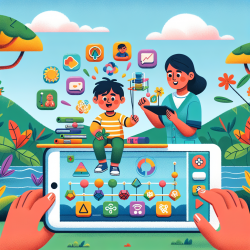Blending online therapy with traditional face-to-face sessions is an innovative approach gaining traction in various therapeutic fields, including speech therapy for children. The research article "Blending online therapy into regular face-to-face therapy for depression: content, ratio and preconditions according to patients and therapists using a Delphi study" provides valuable insights that can be adapted to enhance speech therapy outcomes for children. Here, we discuss the study's key findings and how practitioners can implement them to improve their therapeutic practices.
Key Findings from the Research
The study employed a Delphi method to reach a consensus among therapists and patients on the optimal blend of online and face-to-face therapy. Key findings include:
- Enhanced Self-Management: Online modules can empower patients to take more responsibility for their therapy, which can be beneficial for older children and adolescents.
- Flexibility and Accessibility: Online components offer the convenience of accessing therapy materials anytime, which can be particularly useful for busy families.
- Therapy Content Distribution: Practical components like assignments and psycho-education can be effectively delivered online, while process-related components such as introductions and evaluations should remain face-to-face.
- Individual Tailoring: The ratio of online to face-to-face sessions should be customized based on the patient's needs, skills, and characteristics.
Implementing Blended Therapy in Child Speech Therapy
Adapting these findings to child speech therapy involves several practical steps:
1. Empowering Self-Management
Online modules can include interactive exercises and games that encourage children to practice speech skills independently. These modules can be designed to be engaging and age-appropriate, ensuring that children remain motivated and invested in their therapy.
2. Enhancing Flexibility and Accessibility
Parents can benefit from the flexibility of online modules, allowing them to incorporate therapy into their child's daily routine without the need for frequent clinic visits. This can be particularly advantageous for families with tight schedules or those living in remote areas.
3. Optimizing Therapy Content Distribution
Based on the research findings, practical components of speech therapy, such as articulation exercises and language games, can be delivered online. Process-related components, including initial assessments and progress evaluations, should be conducted face-to-face to ensure a thorough understanding of the child's needs and progress.
4. Tailoring to Individual Needs
Each child's therapy plan should be tailored to their specific needs. For example, children who are more comfortable with technology may benefit from a higher ratio of online sessions, while those requiring more hands-on guidance may need more face-to-face interactions. Regular assessments can help adjust the therapy blend as needed.
Encouraging Further Research
While the study provides a solid foundation, further research is necessary to determine the cost-effectiveness and long-term outcomes of blended therapy in child speech therapy. Practitioners are encouraged to participate in or conduct studies that explore these aspects, contributing to a growing body of evidence that supports data-driven decisions in therapeutic practices.
To read the original research paper, please follow this link: Blending online therapy into regular face-to-face therapy for depression: content, ratio and preconditions according to patients and therapists using a Delphi study.










